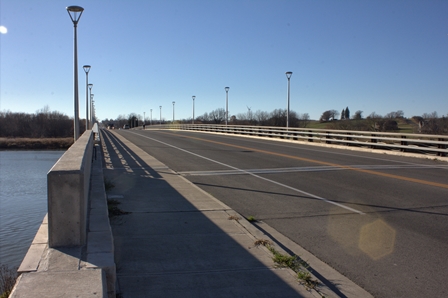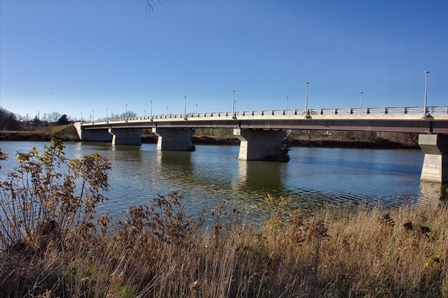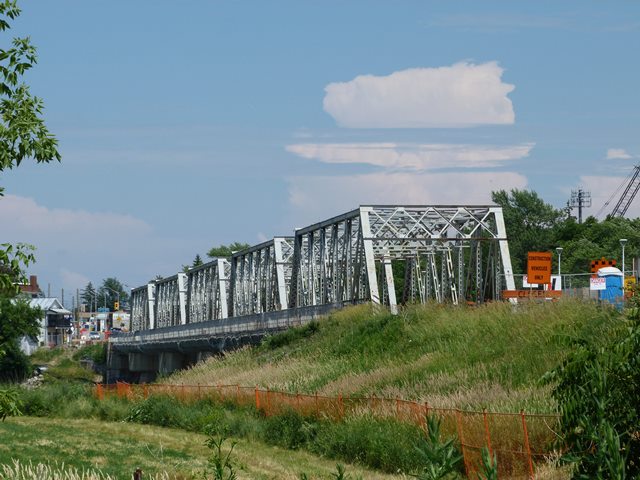We Recommend:
Bach Steel - Experts at historic truss bridge restoration.
BridgeHunter.com Phase 1 is released to the public! - Visit Now
Cayuga Bridge
King's Highway 3 Grand River Bridge

Primary Photographer(s): Nathan Holth
Bridge Documented: 2005, March 20, 2012, and June 29, 2014
1976
123.8 Feet (37.7 Meters)
619.0 Feet (188.7 Meters)
23 Feet (7.01 Meters)
5 Main Span(s)
Not Applicable

View Information About HSR Ratings
Bridge Documentation
This bridge no longer exists!
This iconic heritage bridge was demolished and replaced in 2014 by Ontario Ministry of Transportation!
About This Bridge
Note: Measurements given for the bridge in the Technical Facts table above are approximate estimates.
This bridge is a five-span Pratt through truss with riveted connections. Each truss span has seven panels. The traditionally composed truss bridge includes riveted built-up beams that include visually pleasing v-lacing on vertical members, and under the top chord. There is a cantilevered sidewalk on the north side of the bridge, with original lattice railing. Lattice railing are also on the road, but only on the south side. It was once common for no railing to be installed in between the roadway and a sidewalk, which accounts for why lattice railing is only on one side of the roadway. Modern Armco style guardrails were added to both sides of the roadway at a later date. Some repairs have been made to the bridge over the years, including some bolted plate steel near the bottom chord connections. Piers and abutments for this bridge are concrete.
With five spans, this bridge is among the longest through truss bridges in Ontario, making it a significant example of this bridge type in the province. Additionally, with a 1924 construction date the bridge is among the oldest bridges on the provincial King's Highway system. Despite minor alterations to the bottom chord connections, the bridge is largely unaltered and thus retains excellent historic integrity.
This bridge is reported to be the second bridge at this location.
Above: Photos showing replacement bridge. Photo Credit: Ed Blasinski
Demolition: A Devastating and Unnecessary Loss For Ontario
When HistoricBridges.org first added this bridge to the Bridge Browser in 2005, this bridge was in decent condition with what appeared to be a functioning paint system and was open to heavy truck traffic with no posted weight limit. At that time, HistoricBridges.org offered praise for the Ministry of Transportation, since at that time it appeared that the bridge was being maintained and preserved. However, since that time, no work was done on the bridge whatsoever, and the bridge deteriorated to the point where a weight limit was posted. Plans were also soon developed to demolish and replace this heritage bridge. The Ministry of Transportation (MTO) may have once cared about preserving heritage bridges but it is clear this is no longer the case. From local municipalities up to the provincial level there has been widespread demolition of heritage bridges in Ontario since at least 2005 and perhaps earlier. This fact, coupled with an extremely low number of preserved heritage bridges is very alarming. It is unclear why Ontario is systematically destroying an entire category of heritage in the province: heritage bridges.
MTO stated that the bridge required replacement because it was in "an advanced state of deterioration." HistoricBridges.org looked at the bridge in 2012 and did not see any evidence of widespread deterioration. A truly deteriorated bridge would normally display widespread section loss and pack rust, which is not present on this bridge. There may be areas of the bridge with deterioration, but they appear to be isolated. Isolated deterioration is typically cost-effective to repair. It is possible that heavy traffic on the bridge may have led to fatigue issues including cracking, which was outside of the scope of HistoricBridges.org's examination of the bridge. However fatigue issues would not have prevented the preservation of this bridge for pedestrian use next to a replacement bridge. Pedestrian loads on a vehicular bridge do not induce the levels of stress that would aggravate fatigue in the steel. Another concern is that it is almost beyond belief that this bridge could have gone from absolutely no weight limit posted in 2005, to "beyond repair" in 2012, only seven years later.
Rather than give serious consideration to rehabilitation of the heritage bridge (perhaps by hiring a consulting engineer with a rich portfolio of successful heritage truss bridge rehabilitations), MTO quickly moved to advocating for a project to demolish and replace the bridge. No serious consideration appears to have been given to another key preservation possibility: leaving the heritage bridge standing next to a replacement bridge, the heritage bridge serving non-motorized traffic only. Another preservation alternative would have been to build a new one-lane bridge next to the heritage bridge, and rehab the heritage bridge, and create a one-way couplet of bridges for vehicular traffic. This solution would eliminate concerns about the narrow roadway of the heritage bridge for vehicular traffic. It also enables one bridge to be closed for repair without closing the entire road. Even after a replacement project was settled on, it does not appear that any consideration was given to relocating and preserving the spans of this bridge in new locations. While it is not likely that another crossing of this length would be available, the individual spans of the bridge could be relocated and reused in new locations for smaller crossings. Given that the spans were serving heavy truck traffic for a provincial highway, they would likely be more than sufficient crossings for rural, municipally owned roads. The spans could also be used for crossings on non-motorized trail systems. With all these preservation possibilities, the plan to reduce this heritage bridge to scrap metal is not the result of the bridge's condition. It is the result of a lack of vision.
For decades, this iconic heritage bridge has been a landmark symbol for the community of Cayuga. With the eastern end of the bridge depositing travelers right into the downtown area, the bridge has also functioned as a gateway into and out of the community. The loss of this bridge will be a major loss for the beauty and identity of Cayuga. The replacement bridge is nothing more than a mundane run-of-the-mill steel stringer bridge. The only thing more plain and ugly than a modern steel stringer bridge would be a pre-stressed box beam bridge. MTO has attempted to make this proposed ugly bridge look nice by proposing non-standard fancier-than-normal guardrails and using stone-shaped concrete form-liners on the abutments to simulate stone. These proposals are little more than superficial embellishments. Mainstream thinking into architectural beauty teaches that true beauty in design must come from the structure itself being made beautiful, not by taking an ugly structure and attaching decorations to it. Furthermore, even if the replacement bridge were designed to actually look attractive, it would still be missing the most important thing that the 1924 truss bridge offers: heritage value. No modern bridge can offer heritage. Only through preservation can a community continue to enjoy the beauty and culture that a heritage bridge offers. MTO managed to demonstrate that it is completely ignorant of what "heritage" is when it claimed that the aforementioned embellishments for the replacement bridge would be "heritage enhancements." Decorations on a replacement bridge, especially those that have nothing to do with the heritage bridge being replaced, should not be called "heritage enhancements."
One of the most absurd aspects of the new construction is that a "viewing area" is to be constructed on Ouse Street. This aspect of the project leads to the same question that must be asked for the Fort Steuben Bridge lookout to be built in the wake of the demolition of that equally iconic bridge in the state of Ohio. The question: What will there be worth viewing? Not only will the replacement bridge lack heritage and beauty, these shortcomings will also have a detrimental effect on the beauty of the Grand River itself.

This bridge is tagged with the following special condition(s): Unorganized Photos
![]()
Photo Galleries and Videos: Cayuga Bridge
Structure Overview
Original / Full Size PhotosA collection of overview photos that show the bridge as a whole and general areas of the bridge. This gallery offers photos in the highest available resolution and file size in a touch-friendly popup viewer.
Alternatively, Browse Without Using Viewer
![]()
Structure Details
Original / Full Size PhotosA collection of detail photos that document the parts, construction, and condition of the bridge. This gallery offers photos in the highest available resolution and file size in a touch-friendly popup viewer.
Alternatively, Browse Without Using Viewer
![]()
Structure Overview
Mobile Optimized PhotosA collection of overview photos that show the bridge as a whole and general areas of the bridge. This gallery features data-friendly, fast-loading photos in a touch-friendly popup viewer.
Alternatively, Browse Without Using Viewer
![]()
Structure Details
Mobile Optimized PhotosA collection of detail photos that document the parts, construction, and condition of the bridge. This gallery features data-friendly, fast-loading photos in a touch-friendly popup viewer.
Alternatively, Browse Without Using Viewer
![]()
Additional Unorganized Photos
Original / Full Size PhotosA supplemental collection of photos that are from additional visit(s) to the bridge and have not been organized or captioned. This gallery offers photos in the highest available resolution and file size in a touch-friendly popup viewer.
Alternatively, Browse Without Using Viewer
![]()
Additional Unorganized Photos
Mobile Optimized PhotosA supplemental collection of photos that are from additional visit(s) to the bridge and have not been organized or captioned. This gallery features data-friendly, fast-loading photos in a touch-friendly popup viewer.
Alternatively, Browse Without Using Viewer
![]()
Maps and Links: Cayuga Bridge
This historic bridge has been demolished. This map is shown for reference purposes only.
Coordinates (Latitude, Longitude):
Search For Additional Bridge Listings:
Additional Maps:
Google Streetview (If Available)
GeoHack (Additional Links and Coordinates)
Apple Maps (Via DuckDuckGo Search)
Apple Maps (Apple devices only)
Android: Open Location In Your Map or GPS App
Flickr Gallery (Find Nearby Photos)
Wikimedia Commons (Find Nearby Photos)
Directions Via Sygic For Android
Directions Via Sygic For iOS and Android Dolphin Browser







